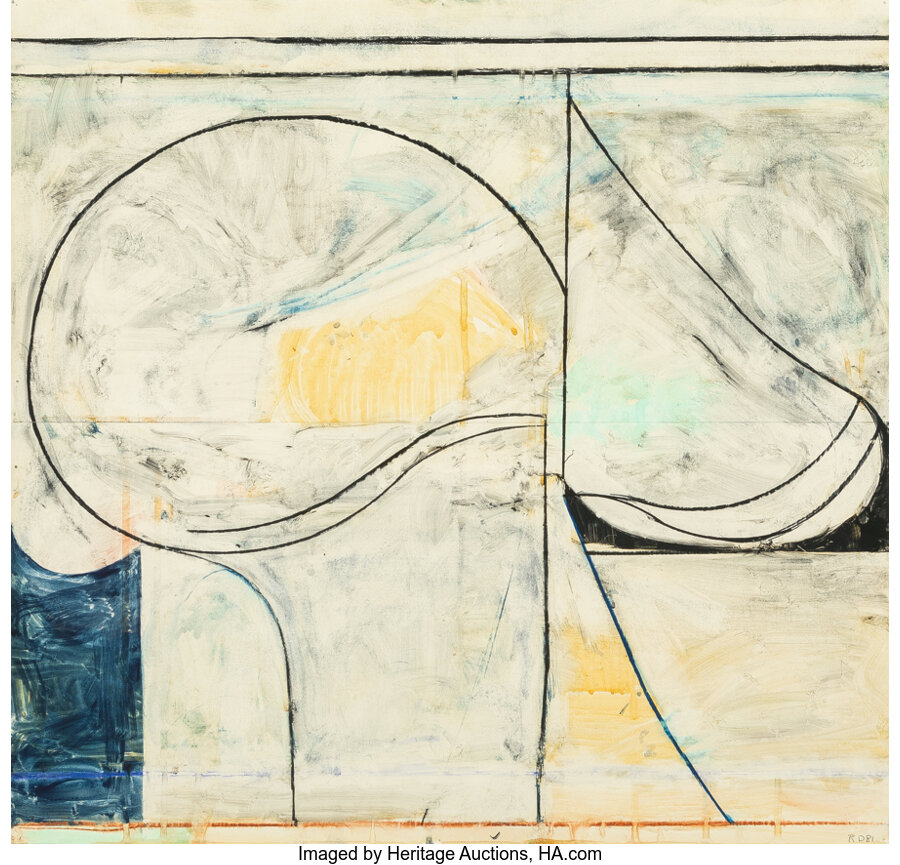Richard Diebenkorn (1922-1993) Untitled, 1981 Gouache and crayon on joined paper 24 x 25 inches (61.0 x 63.5 cm) (sheet) Initialed and dated lower right: RD81 Property from the Estate of Matthew Healy PROVENANCE: M. Knoedler & Co., Inc., New York, 1982; Mr. and Mrs. Clarence Schwerin, 1982; Leslie Feely Fine Art, New York, 1997; Acquired by the present owner from the above, 1997. EXHIBITED: M. Knoedler & Co., New York, Richard Diebenkorn, January 9-28, 1982, no. 13. LITERATURE: M. Knoedler & Co., New York, Richard Diebenkorn, exhibition catalog, January 9-28, 1982, p. 8, no. 13, illustrated; J. Livingston and A. Liguori, eds., Richard Diebenkorn: The Catalogue Raisonné vol. 4, New Haven, 2016, p. 322, no. 4488, cat. no. RD184, illustrated. Richard Diebenkorn (1922–1993) was a leading figure in postwar American art, known for his movement between abstraction and figuration, and for forging a uniquely West Coast modernism. Born in Portland, Oregon, Diebenkorn moved with his family to San Francisco in 1924. He began studying at Stanford University in 1940, where his professors introduced him to the work of European modernists such as Matisse and Cézanne, as well as American painters like Edward Hopper, whose sense of light and spatial tension left a lasting impression. His studies were interrupted by World War II, during which he served in the U.S. Marine Corps from 1943 to 1945. After the war, Diebenkorn resumed his art education at the California School of Fine Arts (San Francisco Art Institute), where he was exposed to the emerging language of Abstract Expressionism. Over the next two decades, he lived and worked in various cities—Sausalito, Albuquerque, Urbana, and most notably Berkeley—where he became a central figure in the Bay Area Figurative Movement. This group of artists merged the gestural freedom of abstraction with the return to representational forms such as the figure, landscape, and still life. In 1966, Diebenkorn moved to Santa Monica and joined the faculty at UCLA. That same year he began what would become the Ocean Park series, a monumental body of geometric abstractions that occupied him for more than twenty years. These works, characterized by luminous fields of color, architectural layering, and an evolving sense of structure, are often regarded as the apex of his abstract work. Diebenkorn remained in Santa Monica until 1988, when he relocated to Healdsburg in Northern California. He continued to produce drawings and smaller works there until his death in 1993. While still immersed in the Ocean Park series, Diebenkorn began a smaller, distinct group of drawings known as the Clubs and Spades series, created between 1981 and 1982. This body of approximately forty works on paper reflects a shift toward a more intimate, experimental mode of working. Unlike the large canvases of Ocean Park, these works are modest in scale, made with gouache, crayon, and collage on paper. Many were constructed from joined sheets—multiple pieces of paper collaged together, with the seams intentionally visible and structurally significant. The name Clubs and Spades refers to recurring motifs drawn from playing cards. These symbols had fascinated Diebenkorn since childhood, when he painted them on handmade shields. He later explained, "I had used these signs in my work almost from my beginnings, but always peripherally, incidentally, and perhaps whimsically. So at this point I dealt with them directly—as theme and variation." The repeated return to these forms allowed him to explore compositional problems through the familiar constraints of symmetry, rotation, and abstraction. Untitled (1981), from this series, exemplifies the strengths of the group. The work is composed of gouache and crayon on paper joined together, creating a surface that interrupts the illusion of a singular, unified space. This seam is not hidden but embraced as a formal element, introducing a break that subtly influences the composition. Against this irregular support, Diebenkorn layers broad, softly brushed areas of color—muted reds, pale yellows, blues, grays—interrupted by drawn lines that oscillate between assertive and tentative. The forms themselves evoke the club and spade shapes without literal illustration. Rounded, bulb-like curves and petal-like silhouettes suggest the suit symbols while simultaneously dissolving into abstraction. The central shape presses gently outward, while the surrounding negative space is charged with tension. The use of collage reinforces the work’s constructed nature, drawing attention to the physical making of the piece. It is not simply a drawing, but a surface built over time—considered, adjusted, and resolved through hands-on engagement. At the time of their creation, the Clubs and Spades works represented a kind of interlude—more private, experimental, and materially direct than the oil-on-canvas works of Ocean Park. Yet they are no less ambitious. These drawings distill many of Diebenkorn’s lifelong concerns—spatial balance, edge relationships, and the conversation between control and intuition—into a more concentrated format. The paper works allowed him to work quickly and responsively, often revisiting forms and motifs across multiple variations. Though they differ in scale and surface, the Clubs and Spades series shares a deep continuity with Diebenkorn’s broader oeuvre. Like his paintings, they reflect a commitment to making the act of composition visible—where decisions are felt, not concealed. In Untitled (1981), we see an artist testing the possibilities of form not through grand gestures, but through the cumulative weight of close, sustained attention. These works do not look past their materials—they honor them. And in doing so, they invite viewers into a space where every mark, shape, and seam has meaning. HID12401132022 © 2024 Heritage Auctions | All Rights Reserved www.HA.com/TexasAuctioneerLicenseNotice



